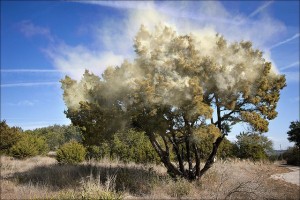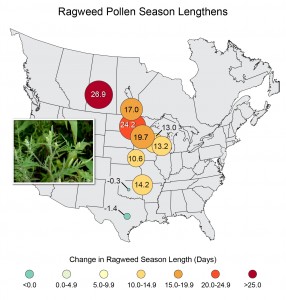How Climate Change Is Making Allergies Worse

Photo courtesy of Flickr/flickr.com/23959586@N00/
In Texas, many people suffer from "cedar fever," a winter allergy caused by the Ashe Juniper.
Thanks to all the pollen in the air, I spent the last few weeks coughing, wheezing and blowing my nose. Austin is infamous for bad allergy seasons. We have three of them: fall, winter, and spring. In the summer, it’s too hot for pollen (but the heat gives me something else to complain about).
Other Texas cities may have even stronger allergy seasons. And it could all get worse thanks to global climate change.
An little-noticed part of the National Climate Assessment, released yesterday by the U.S. Global Change Research Program, explains how: climate change results in “more frost-free days and warmer seasonal air temperatures,” according to the report. That can mean longer pollen seasons.
Even worse news for allergy sufferers is this tidbit: “Increased carbon dioxide [CO2] by itself can elevate production of plant-based allergens … Higher pollen concentrations and longer pollen seasons can increase allergic sensitizations and asthma episodes … and diminish productive work and school days.”
In a nutshell: plants eat CO2; more plants mean more pollen; and more pollen means worse allergies.
To back up its statements, the assessment cites a 2011 study showing how ragweed allergy seasons have lengthened in parts of North America.
That study says:
“… Data indicate a significant increase in the length of the ragweed pollen season by as much as 13 – 27 d at latitudes above ∼44°N since 1995. This is consistent with recent Intergovernmental Panel on Climate Change projections regarding enhanced warming as a function of latitude. If similar warming trends accompany long-term climate change, greater exposure times to seasonal allergens may occur with subsequent effects on public health.”
It’s interesting to note that ragweed pollen actually decreased in Texas (as measured in Georgetown) during the time sampled for the report. But its increase in more northern climates was so dramatic they offset that decrease.
That suggests climate change might improve allergy conditions, at least for some plant species in some regions. But before Texas allergy sufferers throw out their kleenex, it would behoove them to note the part of the assessment that says “simultaneous exposure to toxic air pollutants can worsen allergic responses.”
So, even in places where there’s less pollen, there could be more sneezin’.
